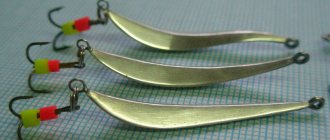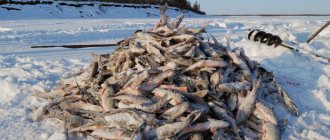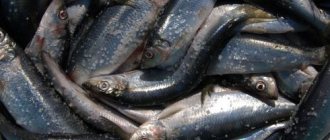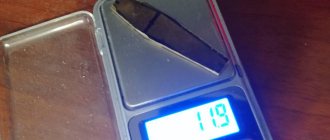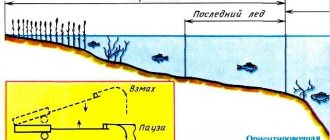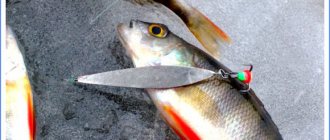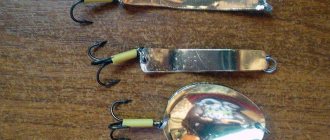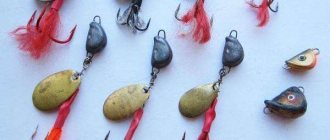Homemade spoon “Dovetail”
A little about the Dovetail lure
Making a winter spinner “Dovetail”
Drawing of a dovetail spinner blank weighing 16 grams To make a Dovetail spinner weighing 16 grams, you need to make a blank as in the picture.
Drawing of a dovetail spinner blank weighing 22 grams
In order to make a spinner weighing 22 grams, the dimensions of the workpiece will look like in this figure.
Transferring the spinner pattern to a sheet of copper Using a gypsy needle or other sharp object, you need to transfer our pattern to a sheet of copper. After that, using metal scissors (you can take ordinary scissors, which you don’t mind, they will do the job just fine) we cut out the workpiece. Let's cut off the tip by 6-7 mm for more convenient fixation of the ear. We carry out tinning of the workpiece
We prepare our workpiece for subsequent soldering. We carry out tinning, I won’t tell you how to do it, I think even a teenager knows this.
Making a groove for better bending
Let's make a groove along the axis of symmetry with a sharp object. This will make it easier to bend the workpiece.
We bend our workpiece with the tinned edges inward.
Connecting the edges of the spinner
Now we bring together the sharp edges of the future spinner as in the picture.
Solder the seam where the sharp edges meet
We solder the seam at the junction of two sharp corners of the workpiece brought together. After the tin has cooled, a hollow is formed at the soldering site into which we will solder the hook.
Preparing the hook and eye
It is better to use a hook with a thick shank. This example uses a size 1/0 hook. To prepare the ear, you can use any hard wire. We will pre-tin the parts of the body kit.
Solder the ear into the workpiece
Now carefully solder the eye of the spinner.
Filling the lure with solder
We begin to deposit solder from the eye to the center of the spoon.
Having reached the seam, we solder the hook, while the solder cools, we try to keep the hook in a gentle position.
Fill the lure with solder
Now fill the remaining part with solder.
Processing the spinner
We process the edges of the spinner with fine sandpaper and GOI paste to acquire shine. After this, we treat the spoon with colorless varnish in 2-3 layers.
Highlight the hook area in red
Paint the hook area with red varnish.
Using a winding ring, we secure the tee.
The dovetail spoon is ready
The Dovetail spinner is ready for fishing from the bottom.
Dovetail spinner for deep water fishing
For fishing in the water column, the spoon is equipped with a tee instead of a soldered hook.
Source
The simplest lightweight spinner made from a tin can
This bait is often used by perch fishing enthusiasts in the wilderness. Using her example, you can see for yourself that homemade catchable spoons can be made even from what is lying under your feet. For this we need:
- tin can (for beer, coffee, canned food, etc.);
- metal scissors;
- a pair of winding rings;
- double or tee size No. 7-8;
- awl;
- sandpaper.
On plain paper we make a drawing of an oval 40 mm long and 20 mm wide. We cut the tin can and straighten it. Having attached the finished pattern to the metal, we transfer its contours using an awl. Cut out the workpiece. Using an awl, we make holes along the edges of the spoon for the winding rings and carefully polish everything, getting rid of paint, irregularities and burrs.
Next, the future spinner should be bent. This can be done by applying the workpiece to a regular kitchen rolling pin. After this, we attach the winding rings and hook.
Such homemade winter lures for perch, given the thickness of the metal from which they are made, should be stored separately from other baits, otherwise they will simply lose their shape and become unusable.
production of winter spinners for catching perch in shallow water
Making winter spinners for perch. Hi all! Today I want to tell you about making two winter lures for perch fishing. Dovetail 25mm.
These two spoons have proven themselves well in catching perch in shallow water up to 1.5 m. I make them in a size of 25 mm. And so let's start: Drawing of spinners with dimensions
We transfer the drawing to a regular notebook sheet in a box, this is what we get:
We carefully cut out with scissors not a square, but just a square with a margin, this will be needed in the future for easier bending of the crown in a vice and paste it onto a sheet of metal that we use for making winter lures. We use regular stationery glue.
We cut out the same squares from metal along the edge of the glued paper. The metal is quite thin, so for cutting it is enough to use ordinary stationery scissors. This is how we get the blanks:
Then we clamp these blanks into a vise along the bend line and bend them at 90 degrees. And with scissors we cut off all the excess around the office, after cutting out the paper can be removed, and the spoon has a dovetail, this very tail that turned out after cutting needs to be brought together, this is what happens:
Then we process the contour with a needle file to give smooth lines:
Then we treat the workpieces from the inside with flux or soldering acid and tin:
For these spinners I use OWNER No. 10 single hooks made of thin wire, and I use rings for attaching the fishing line from any other suitable hooks:
The hook and ring should also be tinned and soldered to the crown. The hook should be soldered: on the Marapedka, with the sting to the crown, and on the Dovetail, with the sting to the solder. After soldering the hook and ring, fill the rest of the crown space with tin. I use POS 61 solder for soldering spinners.
Next, through simple manipulations using a file and a needle file, we give the spoons an aesthetic appearance. We grind off the excess solder along the crown, grind it carefully, do not grind off the crown, as soon as the file scrapes along the crown, a metallic sound will immediately be heard, this should not be allowed. After grinding off the excess tin, we process the spinners with No. 0 sandpaper, and then polish them with GOI paste. Personally, according to my observations, perch do not really like very shiny objects, so I rub the crown with a regular office eraser so that it does not give a strong shine. Next, we equip the hook of the spoon with cambrics (yellow and red) and our spoons are ready for use.
After weighing, the spoons turned out to be 1g each.
As a rule, these spinners do not require further adjustment of the game. They can be made with either a single hook or a tee. The dimensions of the spinners can be varied up to 40 mm. To make them I use metal up to 0.3 mm thick, brass or nickel silver.
Source
Winter lures for catching perch
"Gliders"
Gliding baits will be more effective in shallow water bodies. These types of baits are in great demand among perch because they have a large playing radius and catch schools of perch from considerable distances.
"Gaskets"
They are more catchy gliders. Weight from 3 grams, and length from 4 cm. The best depth is 4-6 meters. Free fall with deviation to the side.
"Carnation"
Can attract the laziest perch. Short wiring is recommended. First, the spoon deviates to the side, and then takes its original position.
"Rombik"
Weight from 4 g, and length - 4 cm. The diamond does not have a large deviation, but still cannot leave the predator alone.
"Parachute"
A separate type of spinner. And their game is different from the game of the “gliders”. The “parachute,” with a short deployment, makes a kind of somersault and descends slowly and strictly vertically.
Triangular and tetrahedral spinners
This type of spinner differs from others in its unique play due to the center of gravity, which is located in the middle of the bait.
Triangular and tetrahedral spoons are called St. Petersburg spoons. When the bait is lowered into the water, it takes a parallel position and, swaying, sinks to the bottom. With this action, the bait imitates a falling leaf, and a large perch cannot help but notice it.
» SWALLOWTAIL IN THE GOLDEN RATIO «
A simple spinner
Despite such high accuracy in proportion, maintaining it during manufacturing does not require ultra-precise cutting or complex bending operations. It is important to adhere to the specified dimensions of the body length of the spinner with an accuracy of plus or minus 1 mm, and for other parameters the accuracy will be even less. After each manufacturing stage, you can adjust the lure to the desired result, which gives more precision in manufacturing.
To make it easier to repeat this bait, a template was made ( photo 2 ). By the way, it seems to me that you can scan it directly from the magazine page, from photo 1, stick it on foil and cut out a blank for the spinner ( photo 3 ). With skillful use of image scaling while maintaining proportions, it is possible to obtain blanks for baits of different sizes, but only with maintaining the catchable proportions of the body of the spoon. When changing the size of the spinner, you will need to adjust the sizes of other components in a similar proportion.
How to make a spinner with your own hands, types of spinners
Fishing in winter differs from fishing in summer primarily in that you have to hunt under the ice. There is a wide variety of winter baits. Gear can be classified according to the degree of edibility: baits, lures and samples made of artificial material. And also according to the parameter for which fish they are intended: for predators or herbivores. Today we will talk about homemade winter lures for perch.
Perch is one of the most common predators, living in almost all reservoirs of the central part of Russia, partly in the Urals. The predator lives in a pack, hunts in small schools that change their location in search of food. The behavior of the predator does not depend on weather conditions; it is very voracious.
Spoon jig
A jig is a heavy, uniform, narrow spoon made of stainless steel, copper, brass, cupronickel and other metals that are slightly susceptible to corrosion. It is used for winter vertical trolling for large perch and pike perch.
In order to make a simple jig, we need:
- an ordinary dessert spoon made of stainless steel or cupronickel;
- hacksaw for metal;
- file;
- drill;
- sandpaper;
- a pair of winding rings;
- treble hook.
First you need to decide on the size of the future spinner. If you plan to go fishing for a large perch, the length of the jig should be 4-7 cm. After cutting the workpiece to the required size with a hacksaw, trim it with a file and sand it with fine sandpaper. Next, you need to drill holes along the edges of the workpiece.
On the one hand, where the width of the workpiece is greater, we attach a tee of the required size through the winding ring. That's it, the jig is ready. Such homemade winter lures for perch work well at medium depths (3-5 m) in reservoirs with moderate currents.
Choosing a spinner: buy a ready-made one and make it yourself
The key player in the spinning rod rig is the artificial fish. The success of fishing depends on the right choice of bait. And this is where the expression “catchable lure” is relevant. What does it mean? And the fact that this is an ideal option for excellent hunting in a specific body of water under certain weather conditions. All these factors vary. That's why baits are different.
Any non-natural food that differs from others in some respects and has successful characteristics receives its own name. It happens that the uniqueness of a design and its authorship are documented. And this fact already suggests that this tackle is worthy of attention. Baits that show good results in fishing are recognized not only by professionals, but also by amateurs.
The quality of the product purchased in the store does not always correspond to the well-known name. We choose by name, and if we have little experience in fishing, we may not even realize that we are not paying for the one that has proven itself and received the given name.
And it happens that, despite external similarity, a specimen does not have the required characteristics due to violations of technology during manufacturing, the use of low-quality materials, and so on. By repeatedly copying a popular model in pursuit of excess profits, the manufacturer misses out on quality characteristics. As a result, the consumer has an item with a loud name and a negative experience of using it.
It has been proven that minor violations in the design lead to a deterioration or change in the performance of the bait. Due to the replacement of qualities, the movement style changes, and the value of the attachment is lost. And so, receiving negative emotions, depriving themselves of the pleasure of high-quality interesting fishing, professionals are forced to produce their own gear, rather than buy ready-made ones.
It is interesting that manufacturers, when copying successful copies, not only do not monitor the quality of the products, but also make mistakes in the names, which leads to confusion. A beautiful bright artificial fish will attract the attention of a beginner, and the manufacturer will thereby receive his revenue. But will the newly baked fisherman return to buying? And will fishing become a favorite pastime if the quality of hunting leaves nothing to be desired?
Design omissions include inconsistencies in the quality and size of equipment. For example, carabiners, hooks, rings, clasps must be coated with anti-corrosion coating. But products are not always processed. Faced with such difficulties and troubles, fishermen are forced to modify products and replace parts where necessary.
All this encourages professional fishermen to make homemade winter lures for perch. It often happens that the lure breaks due to hooks. And losing a nozzle is not very pleasant. Therefore, professionals go to the trouble of finalizing the design. And this event often ends with the production of homemade winter lures for perch with dimensions corresponding to the equipment available in the arsenal.
By making baits with their own hands, fishermen receive baits that are in no way inferior in quality to proven industrial models. A winter lure for perch can easily be made with your own hands at home if you follow all the recommendations during the production process and will show excellent performance.
In any body of water it is easier to catch perch than other predators such as pike and pike perch. The bait for striped bully is smaller in size than for pike, which means it is easier to make and can also be tested in any body of water. Since the desired fish is small in size, it requires a bait from 20 to 50 mm and a weight of up to 10 grams.
You should start copying with industrially produced baits that work well. And once your skills have been honed, you can move on to implementing your own improvements.
Let's take a closer look at what homemade spinners you can make with your own hands.
Trapezoidal spinner.
This is an oblong trapezoid, its center is concave.
Manufacturing should begin by marking a trapezoid on the base of a metal plate with a wide edge of 9 mm, a narrow edge of 6 mm, and a length of 40 mm.
Using metal scissors, cut according to the template, level it with a hammer, file the edges, and clean the surface with sandpaper. Using a hammer, give the product a boat shape and fill it with solder. After the mass has cooled, level it using a knife and file. Drill holes on both sides of the structure, process them and thread the winding rings. Attach a tee on the wide side of the bait, and a fishing line will be attached on the narrow side.
In order to make the spoon more attractive to perch, you can decorate it with red cambric and partially paint it. Due to its geometric parameters, this bait shows stable play. This DIY winter lure for perch is suitable for deep-sea fishing up to 8m.
Winter spinner made using a matrix
The matrix allows you to get bait of any shape. What is the principle: a pre-prepared matrix is used. A pattern is made, i.e. The contours of the product are applied to paper or any other more solid base, the pattern is cut out, and then transferred to a metal blank and traced. Next, all that remains is to cut out the product of the desired shape, drill holes, and process the edges. Then place the product in the matrix and bend it with a hammer. At the very end, secure the winding rings.
The technology can be used in the manufacture of spinners of almost any shape.
Leaf-shaped spinner
The name of this type is dictated by its configuration. For manufacturing, it is necessary to make markings on a sheet of metal.
Length 40-42 mm, width 12-14 mm, width at the bottom at the attachment point is about 1 mm, at the top - about 2 mm. The plate should have a thickness of 0.3 mm.
First you need to cut a rectangular blank and give it a bend of no more than 1.5 mm. Only then cut the corners to make a diamond shape. Round off sharp corners with a file. Now you need to fix the ears. For this, wire or 2 long ears from a hook are suitable, from which you first need to cut a piece with a bend. The resulting ears are soldered to the body.
Next, the concave part of the bait is filled with solder. To prevent previously attached parts from coming off, heat should be removed by placing the lure on a metal object - corners, weights. Excess solder is removed with a file. It is necessary to obtain a product with a thickness of 2 mm at the top and 1.5 at the bottom. Now we fix the tee and the bait is ready.

